Diwali, also known as Deepawali, is a festival steeped in tradition, history, and cultural significance, celebrated with great fervour across India and in various parts of the world. This festival of lights, transcending religions and regions, brings with it a message of hope, joy, and the triumph of good over evil.
To truly appreciate the depth and breadth of Diwali, one must delve into its historical origins, understand the reasons behind its celebration, explore its diverse manifestations across different regions of India, grasp its economic impacts, and recognize the growing need for eco-friendly celebrations.
The historical background of Diwali is as diverse as the country itself, with numerous legends and stories associated with its celebration. While North India primarily celebrates Diwali to commemorate the return of Lord Rama, South India celebrates it as the day Lord Krishna defeated the demon Narakasura. For many, Diwali also marks the worship of Goddess Lakshmi, the deity of wealth and prosperity, signifying the prayers for material and spiritual wealth.
Unity in Diversity: The Multifaceted Celebrations of Diwali in India
India, with its kaleidoscope of cultures and traditions, exhibits a breath-taking array of Diwali celebrations, each unique to its region and community. The festival, transcending religious boundaries, has become a national festival marked by joy, lights, and togetherness.
In the northern parts of India, Diwali is a boisterous affair, marked by an outburst of fireworks, the illumination of homes with oil lamps and electric lights, and the preparation of an assortment of sweets. Families come together, exchange gifts, and participate in prayers, often seeking the blessings of Lord Rama and Goddess Lakshmi. Children and adults alike revel in the night skies ablaze with fireworks, symbolizing the victory of light over darkness and good over evil. The markets are abuzz with activity, selling everything from festive attire to intricate jewellery, catering to the heightened demand of the season.
Moving down south, the festival takes on a more serene, introspective nature. Here, Diwali is celebrated to commemorate Lord Krishna’s victory over the demon Narakasura, symbolizing the banishment of ego and the awakening of the divine light within. Homes are adorned with beautiful kolams (rangoli) made from rice flour, and families partake in early morning oil baths, a ritual believed to purify the body and soul. The air is filled with the sweet scent of jasmine flowers and freshly made sweets, creating an atmosphere of calm and reverence.
In the western states, particularly in Gujarat, Diwali is celebrated with great fervour and is closely associated with the worship of Goddess Lakshmi. The day after Diwali marks the beginning of the New Year in the Gujarati calendar, and businesses open their accounts afresh, seeking the blessings of the goddess for prosperity in the coming year. Homes and business establishments are illuminated with lamps and rangoli, and the skies are lit with fireworks as families and communities come together to celebrate.
In the eastern part of the country, particularly in Bengal, Diwali is synonymous with the worship of Goddess Kali, the fierce embodiment of Shakti. Temples are adorned with lights and flowers, and devotees flock to offer their prayers and seek blessings. The celebrations here are marked by a sense of devotion and respect for the divine, with less emphasis on the pomp and grandeur seen in other parts of the country.
Across the different regions, what remains constant is the spirit of Diwali a time to celebrate life, to cherish family and friendships, and to kindle the light of knowledge and goodness within. It is a time to clean and decorate homes with diwali decoration materials, symbolizing a fresh start, and to indulge in sweets and delicacies, signifying the sweetness of life. Diwali serves as a reminder that despite our differences, there is a common thread of joy, light, and unity that binds us all.
Economics Behind the Festival of Lights
Diwali is not just a cultural and religious festival; it is also an economic linchpin for several job industries across India. The festival period sees a significant surge in consumer spending, as people indulge in shopping for clothes, gifts, decorations, and delectable sweets.
DIWALI Decoration Materials | LED Decorative Lights
Small businesses and artisans, particularly those involved in creating traditional items like diyas (oil lamps), candles, and handicrafts, experience a substantial boon in sales during this time.
Beyond immediate retail, there is an evident positive ripple effect in other sectors too. The festival boosts the hospitality and tourism industries, with hotels often being fully booked and transportation services in high demand, as individuals travel across the country to reunite with family or simply to partake in the grandeur of regional Diwali celebrations. Additionally, the real estate and automobile industries often witness heightened activity, as many families consider Diwali an auspicious period to make significant investments or start new ventures.
Financial institutions and banks also benefit, as they roll out special festive offers and schemes, leading to an increase in loans and credit card spending. Advertising and marketing sectors equally thrive, as brands launch targeted campaigns to captivate potential consumers. In essence, Diwali’s economic impact is a testament to its significance in the socio-cultural fabric of India, driving both sentiment and commerce in a harmonious blend.
Eco-Friendly Diwali: Respecting the Earth
In recent years, concerns over environmental degradation have led to a call for a more sustainable celebration. Firecrackers, though deeply embedded in Diwali festivities, cause air pollution, and their residual debris can harm aquatic life when dumped into water bodies.
An eco-friendly Diwali focuses on using biodegradable materials, promoting hand-made and locally sourced decorations, and minimizing the use of firecrackers. Opting for clay lamps instead of plastic lights, using natural colours for rangoli, and recycling wherever possible are small steps toward a greener celebration. After all, what better way to honor the triumph of diwali lights over darkness than ensuring our celebrations don’t cast a shadow on our planet?
In conclusion, Diwali, with its deep historical roots and diverse celebrations, remains an intrinsic part of Indian culture. While the economic benefits are palpable, there’s a growing emphasis on ensuring the festivities are in harmony with the environment. As the world evolves, so must our traditions, ensuring they remain relevant and responsible.
BanteyBanatey is an online venture by Papyrus, Indore for art and craft, stationery, resin art kits, lapox epoxy resin hardener, epoxy resin molds, resin pigments, gifting, alcohol inks, party supplies, and gifting.





